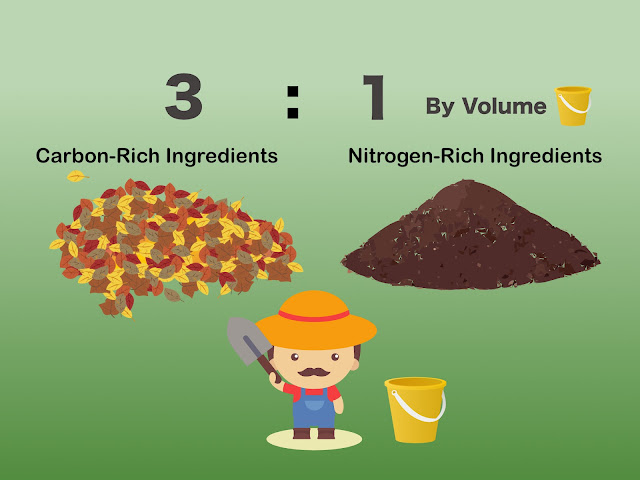Composting is a scientific art. To freely practice art, we need to learn precise techniques. Getting the precise carbon to nitrogen ratio (C/N ratio) is crucial in composting because it decides if your pile will ever finish or not.
Carbon burns to gives human body energy, while nitrogen build body cells. Same rule for bacteria. Bacteria use carbon to gain energy and nitrogen to build their bodies. So, if you have carbon but don't have enough nitrogen in your composting pile, the population of bacteria will be limited so your pile will never finish. However, if you have too much nitrogen but not enough carbon in the pile, bacteria won't have the energy to work though the nitrogen so the pile will have excessive nitrogen and it will smell like rotten egg.
Getting the right CN ratio in the beginning will make composting easier until the end. For mixing the composting ingredients, you may hear that the ideal Carbon to Nitrogen Ratio is 30:1 (by weight). It was vague to me but I finally figured out how it works : All ingredients contain carbon and nitrogen to a ratio as the table below.
Example:
For 180 gram of corn stalk, there are about 177g carbon and 3g nitrogen (60:1). While for 180 gram of chicken manure , there are about 162g carbon and 18g nitrogen(10:1). So chicken manure is a bigger source of nitrogen than corn stalk.
| Carbon Rich Ingredients | CN Ratio | Nitrogen Rich Ingredients | CN Ratio |
|---|---|---|---|
| Corn Stalks | 60:1 | Chicken Manure | 10:1 |
| Corrugated Cardboard | 600:1 | Coffee Grounds | 20:1 |
| Dry Leaves | 40-80:1 | Garden Plants and Weeds | 20-35:1 |
| Mixed Paper Products | 200-800:1 | Grass Clippings | 10-25:1 |
| Newspaper | 150-200:1 | Hay | 10-25:1 |
| Pine Needles | 60-100:1 | Kitchen Scraps(No Dairy, meat, fish) | 10-50:1 |
| Sawdusts, weathered 3 yrs | 142:1 | Rotted Manure | 20-50:1 |
| Sawdusts, weathered 2 months | 625:1 | ||
| Straw | 50-150:1 | ||
| Woody Plants trimmings | 200-1300:1 |
Carbon to Nitrogen Ratios Source: Composting for Dummies P. 108 , 2010, Wiley
If you are good at math, you know it's impossible to measure and calculate the weight of each ingredient precisely! Thus, just remember a practical ratio for mixing the carbon-rich and nitrogen-rich ingredients is 3: 1 by volume. This simple rule works, guarantee!
 |
| Classify carbon- and nitrogen-rich ingredients. Repeat taking 3 buckets of carbon and 1 bucket of nitrogen and mix them |
The steps I found practical are:
1. Classify all your ingredients into two types: Carbon rich and Nitrogen rich ingredients. Set two heaps respectively.
2. Get a bucket. When you take 3 buckets of carbon-rich ingredients, take 1 bucket of nitrogen-rich ingredients and well mix them.
Farmer Vectors by Vecteezy





0 Comments